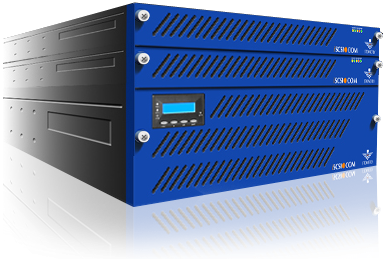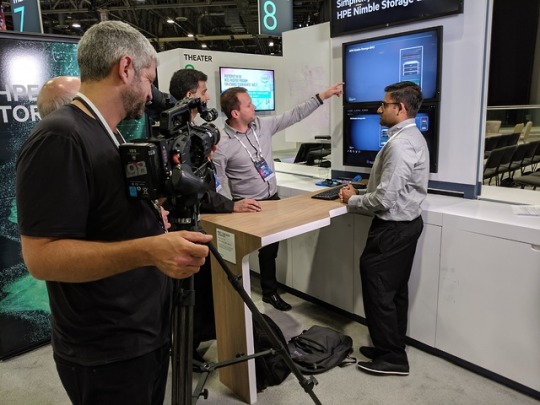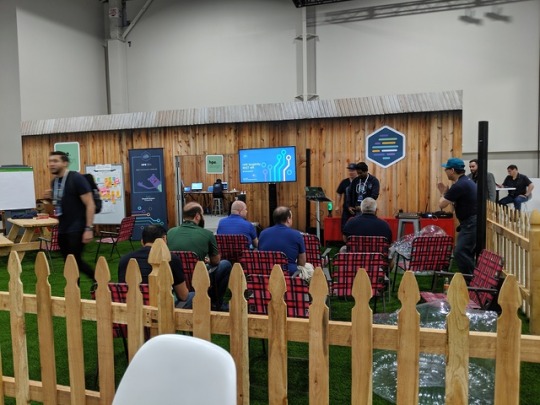#disaggregated hci
Explore tagged Tumblr posts
Link
Discover more about HPE Nimble Storage disaggregated hyper converged infrastructure, the intelligent cloud platform for virtual machines that combines the ease of HCI with the flexibility of converged infrastructure.
#disaggregated hci#intelligent cloud#intelligent cloud platform#hpe nimble storage dhci#virtual machine platform
0 notes
Link
HPE Nimble Storage dHCI, a disaggregated hyperconverged technology that gives the HCI experience without any of the sacrifices, is offering HCI 2.0.
#disaggregated hci#intelligent cloud#intelligent cloud platform#hpe nimble storage dhci#virtual machine platform
0 notes
Text
Expanding the HCI Experience to More Workloads: Factors to Consider
This IDC Analyst Connection report explains that some IT managers are looking to apply the HCI experience to more workloads by pairing it with disaggregated compute and storage resources. Please contact BbuyTech for more information about HCI 2.0.
View: Expanding the HCI Experience to More Workloads: Factors to Consider
0 notes
Text
Expanding the HCI Experience to More Workloads: Factors to Consider
This IDC Analyst Connection report explains that some IT managers are looking to apply the HCI experience to more workloads by pairing it with disaggregated compute and storage resources. Please contact Trivoshop Inc for more information about HCI 2.0.
View: Expanding the HCI Experience to More Workloads: Factors to Consider
0 notes
Text
StoneFly USS-HA™ – High Availability Disaggregated Hyperconverged Storage Appliance
The HCI controllers comprise of the virtualization layer (with the hypervisor) and the management layer that enables management of the hyperconverged storage resources.
https://stonefly.com/hyper-converged/appliance

#data#data security#data protection#bigdata#data storage#data center#hyper-converged#hyperconverged storage#hybrid cloud
0 notes
Text
HPE Discover 2019
If you’ve been following this feed it’s been hard to miss that I’ve been to HPE Discover in Las Vegas this week. On that same note, you’ve probably been overwhelmed by all the announcements coming from HPE Storage.
HPE Primera, tier-0 redefined!
HPE InfoSight for HPE SimpliVity, ten years of machine learning applied to the entire HPE SimpliVity install base
HPE Nimble Storage dHCI, simplicity of HCI with the flexibility of CI (more below)
HPE Hybrid Cloud for Google Cloud Anthos, delivered on HPE Nimble Storage dHCI
HPE Blue Data, AI/ML workloads for the mainstream, GPUaaS delivered end-to-end by HPE
The storage team had a 1 hour session to deliver the key messages around all these technologies, they did a phenomenal job in an incredibly condensed session. Antonio and Phil Davis also made a few key remarks during the HPE Discover keynote session.

You could feel the energy resonate in the transformation showcase during the ribbon cutting ceremony, the dHCI rack was cut by Omer Asad, our GM for HPE Storage.
HPE Nimble Storage dHCI
I wanted to elaborate a little bit more on what dHCI actually is, as I don’t think we can evangelize enough what it is. I had the opportunity to present dHCI at a partner event a few months ago and had to learn some of the cornerstone pitches and the technology underpinnings. To properly set the context, I usually refer to this article posted on El Reg in 2017. As you can see, Suresh knew just a tad bit much about HCI for comfort given we were “just” a storage company. That said, at that time of writing, Nimble had been working on a HCI platform for over a year. We got acquired, just shortly after SimpliVity got acquired, and there would obviously be a conflict of interest. Since the acquisition we’ve rearchitected the experience to be referred to as a disaggregated hyper-converged infrastructure for virtual machines.
I have bias, obviously since I’m an HPE employee, but the dHCI platform is an entirely new experience on how to deploy, manage and operate virtual infrastructure. Details might not have come across how dHCI actually works but the customers that has been asking me “what it actually is”, I’ve been quite frank. NimbleOS with the dHCI firmware flag is able to discover ProLiant servers and create ESX clusters, setup everything for you according to every known best practice. Once the “wizard” have cooked up the cluster all the management (day 2, upgrades, conformance check, etc) is done by our completely revamped vCenter plugin and brand new InfoSight dashboards for dHCI. The end-game here is that the virtual infrastructure admin never leave vCenter to manage dHCI and InfoSight will alert the admin if any problems arise. A classic Nimble experience. Without promising too much (and not getting in trouble), there are some gaps in managing a few aspects of the solution that might need to resort to each of the component’s dedicated interfaces, one of those is using the NimbleOS web UI to manage replication.

All said and done, I’m extremely proud of the team on the floor and all the engineers building the dHCI platform. This is an industry first and rest assured there will be copycats. Anyone who’s familiar will traditional CI systems (I’m looking at you FlexPod and vBlock) knows the pain of plowing hundreds of pages of documentation, white glove services and painstakingly difficult upgrades (if available?) and management through disparate interfaces and toolchains.
At the Hack Shack

I spent HPE Discover decked out in full HPE DEV gear and ran two workshops at the hack shack. I wish I had prepared a few challenge as well to interact more with customers and partners that want to explore more about Nimble and our container integration. It was a great learning experience for me personally and the HPE DEV community is a great crowd, through and through. You may find the presos on slidehare: Nimble REST API and Kubernetes.
Around in Las Vegas

HPE Discover is hosted at the Venetian, a classic middle of the strip casino borrowing features from Venice.

The HPE Storage customer appreciation event took place at a nightclub at the Wynn. It was a great turnout and it’s always fun to meet up with customers and coworkers from around the world.


I attended a partner dinner event the same day as the main HPE Discover party took place. I did however manage to get a glimpse of the last few moments The Chainsmokers performed. I think I spent more time capturing the perfect shot of the massive #HPEDiscover mural on this container than watching The Chainsmokers. :-)
Around the transformation showcase

Walking the showfloor is an experience in itself, besides great partners and our own solutions, there’s also customers and memoriabla from past lives. Replica model of Disney Park Star Wars: Galaxy's Edge.

This ProLiant had ’94 vintage (stamped on the motherboard) and I recognized the drive carriers from that era. Nostalgic!
Summary

I hope to get nominated next year again for Discover. It’s a great event and the pinnacle of what we’ve accumulated over the year. I’ve done so many events the last few months that today is the first day I don’t have flight booked within the next three weeks. That also translates quite well to that I have a ton of work piled up. See you soon indeed!
#HPEDiscover#NimbleStorage#dHCI#HPE#LasVegas#ProLiant#Chainsmokers#StarWars#GalaxysEdge#Primera#SimpliVity#BlueData#InfoSight
0 notes
Text
Windows Admin Center 1904 released

Windows Admin Center 1904 released. There are too many additions to list them all, so here’s a summary of some key new and improved features added to Windows Admin Center since 1809…
User experience
Shared connections: With the ability to add shared connections, gateway administrators can configure the connections list once for all users of a given Windows Admin Center gateway. Add connections from Active Directory: Optionally search Active Directory when adding servers or Windows 10 PCs to a connections list. You can use wildcards in your search and bulk add multiple search results. Dark mode theme: Try out the new dark mode UI theme! It’s as easy as toggling the option under Settings->User->Personalization.
Platform
Fundamentals: Various quality and functional improvements and bug fixes, including accessibility, notifications, elevation experience, high-availability deployment improvements, etc. PowerShell module for connections: Use PowerShell to automate or programmatically import or export connections, including support for tags and shared connections. For RDCman users, check out the script which exports your RDCman connections for import into Windows Admin Center, while maintaining your grouping hierarchy using tags! PowerShell module for extensions: Use PowerShell to automate or programmatically configure extension feeds, extension details, and install/update/uninstall extensions.
Core tools
Power options: Use the Power configuration tab in the server settings page to change the configured power profile. For example, select the High performance power plan to get the most out of your Hyper-V hosts. Platform hardware access: If your server has an IPMI-compatible BMC, you’ll find the BMC serial number and a hyperlink to its IP address on the Server Overview page. VMs can now use SMB shares for storage: Create and configure VMs to use disaggregated storage with SMB file shares. Set the default VM configuration file and VHD file path to remote file shares in the Hyper-V host settings, create VMs using the default host setting or browse and choose a custom remote file share path, and point to .iso files on file shares to install the OS for the VM. Containers tool: The Containers tool has exited preview and an updated version is available to install from the Extensions manager in Settings. It includes some style updates and accessibility fixes. Active Directory tool (Preview): Available to install from the Extensions manager in Settings, the AD tool currently lets you view domain details, create and manage users and groups, membership and details, search, enable/disable and remove user and computer objects, reset password, and configure resource-based constrained delegation on a computer object. DNS tool (Preview): Available to install from the Extensions manager in Settings, the DNS tool currently lets you view, create and configure forward and reverse lookup zones and DNS records and properties. DHCP tool (Preview): Available to install from the Extensions manager in Settings, the DHCP tool currently lets you view scope details like IP status and usage, and address exclusions and reservations, create scopes and scope properties, create address exclusions and reservations.
Hybrid
Azure hybrid services tool: Consolidating all of Windows Admin Center’s optional Azure services into a centralized hub, the Azure hybrid services tool lets you easily discover and leverage the value that Azure can bring to your on-premises or hybrid environment. Azure Monitor (Preview): Configure custom email notifications about your server health, using the robust alerting framework of Azure Monitor. With Azure Monitor’s free 5 GB of data per month/customer allowance, easily try it out for a server or two without worry of getting charged. Additional benefits include a consolidated view of systems performance across the servers in your environment. Azure File Sync (Preview): Centralize your organization's file shares in Azure, while keeping the flexibility, performance, and compatibility of an on-premises file server. Azure File Sync transforms Windows Server into a quick cache of your Azure file share with the optional cloud tiering feature. Storage Migration integration with Azure File Sync: Synergize migration with Azure File Sync (AFS). The Storage Migration Service leads to the AFS experience, so you can migrate from an older version of Windows Server to Windows Server 2019 and automatically deploy AFS to manage that data. Storage Migration directly into Azure: Optionally choose direct-to-Azure storage migrations with Storage Migration Service, so you can migrate from Windows Server 2003, 2008, 2012, or Linux Samba directly to a running IaaS VM in Azure. Azure Backup (improvements): Real-time monitoring of backup jobs, use existing Recovery Services Vaults, opt for the same backup schedule and settings across Files and System State backups, and error-handling and stability improvements. Automate deployment in Azure: Download and run our new script inside Azure Cloud Shell to set up a Windows Admin Center gateway in Azure. This script can create the entire environment, including the resource group.
Hyperconverged infrastructure (HCI)
Clustering and Hyper-V: Enhancements for Cluster Aware Updating; add/remove virtual hard disk for running VMs; VM Connect web console in the Virtual Machines tool on Failover Cluster and HCI Cluster connections; performance improvements on Windows Server 2019 HCI clusters; and Azure Site Recovery protection status is shown for VMs across all cluster nodes. Storage Spaces Direct: New drive latency and error statistics give deep visibility into SSD and HDD performance; a new Diagnostics tool provides one-click data collecting for troubleshooting; multi-select bulk actions for drives, volumes, and servers; and improved network activity and resync monitoring. Software-Defined Networking: Three powerful new tools: use Access Control Lists to manage data traffic flow by applying policies to virtual subnets; Gateway Connections, which supports all three types – IPSEC, GRE and L3; and Logical Networks management and monitoring. There are also many feature enhancements, like the ability to connect your VMs to a VLAN or Virtual Network directly within VM Settings.
Extensibility and extension experience
Extension availability and update notifications: A notification will now appear in the Server/Cluster Overview page when you connect if an extension that supports the hardware manufacturer and model is available. You see these notifications as partners release extension updates that support this feature. Also, a notification will appear when you open a tool and an update is available, with an “Update now” link to easily ensure you are on the latest version of the extension. Updated SDK design toolkit: Rapidly mock up extension designs in PowerPoint using the latest updated Windows Admin Center styles, controls, and page templates! Updated SDK development guides: We've moved from Angular 5 to Angular 7, introduced a new set of styles, and made updates to many of our controls.
Windows Admin Center ecosystem
Growth: Partners are continuously adding new features and releasing extension updates and three new partners have released extensions since our last major GA release in September. We are also working with several other partners aiming to release extensions later this year. Lenovo XClarity Integrator: Released in January, Lenovo’s solution provides a high-level view of all your Lenovo servers, allowing you to connect to Lenovo XClarity Administrator, Lenovo rack or tower servers, or all the servers in an entire chassis at once. You can then view the hardware health and status of individual servers and a summary dashboard of hardware health and firmware consistency across an entire cluster. NOTE: Lenovo XClarity users, please read this known issue before upgrading to Windows Admin Center 1904. QCT Management Suite: Released in February, the GA version of QCT’s Management Suite extension added support for a couple of specific WSSD certified QCT server solutions, includes visualizations for hardware temperature, power, air flow, and disks, including a disk replacement wizard. This week, another update brings support for dark mode UI theme, disk S.M.A.R.T information such as disk health status and model details, and firmware update capabilities for NIC, HBA, BIOS and disks. NEC ESMPRO: Released earlier this month, NEC’s ESMPRO extension for Windows Admin Center enables showing hardware and RAID information for NEC Express5800 series servers by retrieving data through the NEC ESMPRO Manager software. See an overview of the system, or detailed information on individual hardware components and system health.
What’s next?
In the coming months, we will resume Preview releases of Windows Admin Center through the Windows Insider Program. Read the full article
0 notes
Text
What Does Converged (CI) and Hyperconverged (HCI) Mean to Storage I/O?
What Does Converged (CI) and Hyperconverged (HCI) Mean to Storage I/O?
What Does CI and HCI Mean to Storage I/O?
Converged Infrastructure (CI), Hyperconverged Infrastructure (HCI) along with Cluster or Cloud In Box (CIB) are popular trend topics that have gained both industry and customer adoption as part of data infrastructures. Data Infrastructuresexists to support business, cloud and information technology (IT) among other applications that transform data into…
View On WordPress
0 notes
Text
HPE SimpliVity 325 Gen10 Gets Power Boost to Support Remote Workers
HPE says the new HCI offer is a net gain opportunity for partners.
HPE on Thursday expanded its remote workforce products and services with the HPE SimpliVity 325 Gen10 hyperconverged infrastructure (HCI) solution. It is based on the 2nd generation AMD EPYC processor. The vendor also announced that HPE Nimble Storage dHCI is available through GreenLake, its as-a-service consumption model.
The new HPE SimpliVity 325 Gen10 HCI platform offers the scalability businesses need to support remote workers and remote workforce workloads, the company said. The 2nd generation AMD EPYC processor offers powerful CPU performance that doubles the number of virtual desktops and reduces the cost.
HPE’s Patrick Osborne
“The COVID-19 global pandemic is an unprecedented situation that is affecting all businesses, our communities and our way of life,” said Patrick Osborne, vice president and general manager, HPE SimpliVity. “As an edge-to-cloud platform-as-a-service company, HPE is here to help our clients bring together the right expertise and technology solutions to meet their most immediate challenges and unexpected demands. With these challenges, customers are looking to rapidly unleash mobile productivity and desktop virtualization. HPE SimpliVity and Nimble Storage dHCI solutions provide performance and flexible payment options for our customers.”
Supports Businesses
HPE SimpliVity addresses the demand for a remote workforce with an intelligent, software defined HCI solution that simplifies the time needed to deploy, manage and scale VDI. Using the 2nd generation AMD EPYC processor drives down the cost for each remote worker by 50%. It’s a small, efficient 1U platform, delivered in a small footprint for entry-level and distributed edge HCI use cases.
Nimble Storage dHCI, HPE’s disaggregated hyperconverged infrastructure, became available globally last October. You can get it through HPE GreenLake, to deliver virtual machine as a service. HPE InfoSight, AI for autonomous infrastructure, powers Nimble Storage dHCI. Nimble Storage dHCI is built for VDI users, business-critical applications and mixed workloads with unpredictable growth.
HPE also expanded Nimble Storage dHCI support for HPE ProLiant DL325, DL385, DL560 and DL580 servers. And it increased the scale of servers supported from 20 to 32. HPE Nimble Storage dHCI allows HPE ProLiant customers to convert their existing server investments into a disaggregated HCI.
HPE says Nimble Storage dHCI simplifies life cycle management. It has one-click, unified software upgrades for server firmware, hypervisor and storage software. You can perform upgrades directly in VMware vCenter.
HPE Financial Services supports the new VDI products and services. Customers can delay payments for up to six months to help with cash flow.
The Partner Opportunity
HPE’s David Wang
“Partners can offer their customers a full-stack solution that allows for the cloud experience on-premises. They can also help customers take their existing services and transform that into an HCI experience,” David Wang, director of product marketing, storage at HPE, told Channel Futures. “This is a huge cost advantage since the customers can attain that HCI experience through a simple upgrade, instead of an expensive rip and replace. This is a net-gain opportunity for channel partners.”
Expect the HPE SimpliVity 325 Gen10 with the new AMD EPYC processor to ship in late May. HPE GreenLake is now available for HPE Nimble Storage dHCI globally. The expanded server support, scale and one-click software upgrade enhancements will be available in the second half of the year.
In early April, HPE responded to the global COVID-19 pandemic with several new offers. The company announced new VDI solutions delivered through HPE GreenLake. Additionally, the vendor announced new financing options through HPE Financial Services.
The new VDI offers are built on either HPE ProLiant or HPE Synergy servers. These offers scale from 80 users to more than 2,000 remote workers. They are designed for Citrix and VMware environments.
For businesses that need a more powerful solution, HPE Moonshot ships with HPE ProLiant m750 server blades for a 70% performance advantage.
HPE SimpliVity 325 Gen10 Gets Power Boost to Support Remote Workers appeared first on https://mymarketlogic.com/ HPE SimpliVity 325 Gen10 Gets Power Boost to Support Remote Workers published first on https://mymarketlogic.com/
0 notes
Text
HPE SimpliVity 325 Gen10 Gets Power Boost to Support Remote Workers
HPE says the new HCI offer is a net gain opportunity for partners.
HPE on Thursday expanded its remote workforce products and services with the HPE SimpliVity 325 Gen10 hyperconverged infrastructure (HCI) solution. It is based on the 2nd generation AMD EPYC processor. The vendor also announced that HPE Nimble Storage dHCI is available through GreenLake, its as-a-service consumption model.
The new HPE SimpliVity 325 Gen10 HCI platform offers the scalability businesses need to support remote workers and remote workforce workloads, the company said. The 2nd generation AMD EPYC processor offers powerful CPU performance that doubles the number of virtual desktops and reduces the cost.
HPE’s Patrick Osborne
“The COVID-19 global pandemic is an unprecedented situation that is affecting all businesses, our communities and our way of life,” said Patrick Osborne, vice president and general manager, HPE SimpliVity. “As an edge-to-cloud platform-as-a-service company, HPE is here to help our clients bring together the right expertise and technology solutions to meet their most immediate challenges and unexpected demands. With these challenges, customers are looking to rapidly unleash mobile productivity and desktop virtualization. HPE SimpliVity and Nimble Storage dHCI solutions provide performance and flexible payment options for our customers.”
Supports Businesses
HPE SimpliVity addresses the demand for a remote workforce with an intelligent, software defined HCI solution that simplifies the time needed to deploy, manage and scale VDI. Using the 2nd generation AMD EPYC processor drives down the cost for each remote worker by 50%. It’s a small, efficient 1U platform, delivered in a small footprint for entry-level and distributed edge HCI use cases.
Nimble Storage dHCI, HPE’s disaggregated hyperconverged infrastructure, became available globally last October. You can get it through HPE GreenLake, to deliver virtual machine as a service. HPE InfoSight, AI for autonomous infrastructure, powers Nimble Storage dHCI. Nimble Storage dHCI is built for VDI users, business-critical applications and mixed workloads with unpredictable growth.
HPE also expanded Nimble Storage dHCI support for HPE ProLiant DL325, DL385, DL560 and DL580 servers. And it increased the scale of servers supported from 20 to 32. HPE Nimble Storage dHCI allows HPE ProLiant customers to convert their existing server investments into a disaggregated HCI.
HPE says Nimble Storage dHCI simplifies life cycle management. It has one-click, unified software upgrades for server firmware, hypervisor and storage software. You can perform upgrades directly in VMware vCenter.
HPE Financial Services supports the new VDI products and services. Customers can delay payments for up to six months to help with cash flow.
The Partner Opportunity
HPE’s David Wang
“Partners can offer their customers a full-stack solution that allows for the cloud experience on-premises. They can also help customers take their existing services and transform that into an HCI experience,” David Wang, director of product marketing, storage at HPE, told Channel Futures. “This is a huge cost advantage since the customers can attain that HCI experience through a simple upgrade, instead of an expensive rip and replace. This is a net-gain opportunity for channel partners.”
Expect the HPE SimpliVity 325 Gen10 with the new AMD EPYC processor to ship in late May. HPE GreenLake is now available for HPE Nimble Storage dHCI globally. The expanded server support, scale and one-click software upgrade enhancements will be available in the second half of the year.
In early April, HPE responded to the global COVID-19 pandemic with several new offers. The company announced new VDI solutions delivered through HPE GreenLake. Additionally, the vendor announced new financing options through HPE Financial Services.
The new VDI offers are built on either HPE ProLiant or HPE Synergy servers. These offers scale from 80 users to more than 2,000 remote workers. They are designed for Citrix and VMware environments.
For businesses that need a more powerful solution, HPE Moonshot ships with HPE ProLiant m750 server blades for a 70% performance advantage.
HPE SimpliVity 325 Gen10 Gets Power Boost to Support Remote Workers appeared first on https://mymarketlogic.com/ HPE SimpliVity 325 Gen10 Gets Power Boost to Support Remote Workers posted first on https://mymarketlogic.com/
0 notes
Text
HPE SimpliVity 325 Gen10 Gets Power Boost to Support Remote Workers
HPE says the new HCI offer is a net gain opportunity for partners.
HPE on Thursday expanded its remote workforce products and services with the HPE SimpliVity 325 Gen10 hyperconverged infrastructure (HCI) solution. It is based on the 2nd generation AMD EPYC processor. The vendor also announced that HPE Nimble Storage dHCI is available through GreenLake, its as-a-service consumption model.
The new HPE SimpliVity 325 Gen10 HCI platform offers the scalability businesses need to support remote workers and remote workforce workloads, the company said. The 2nd generation AMD EPYC processor offers powerful CPU performance that doubles the number of virtual desktops and reduces the cost.
HPE’s Patrick Osborne
“The COVID-19 global pandemic is an unprecedented situation that is affecting all businesses, our communities and our way of life,” said Patrick Osborne, vice president and general manager, HPE SimpliVity. “As an edge-to-cloud platform-as-a-service company, HPE is here to help our clients bring together the right expertise and technology solutions to meet their most immediate challenges and unexpected demands. With these challenges, customers are looking to rapidly unleash mobile productivity and desktop virtualization. HPE SimpliVity and Nimble Storage dHCI solutions provide performance and flexible payment options for our customers.”
Supports Businesses
HPE SimpliVity addresses the demand for a remote workforce with an intelligent, software defined HCI solution that simplifies the time needed to deploy, manage and scale VDI. Using the 2nd generation AMD EPYC processor drives down the cost for each remote worker by 50%. It’s a small, efficient 1U platform, delivered in a small footprint for entry-level and distributed edge HCI use cases.
Nimble Storage dHCI, HPE’s disaggregated hyperconverged infrastructure, became available globally last October. You can get it through HPE GreenLake, to deliver virtual machine as a service. HPE InfoSight, AI for autonomous infrastructure, powers Nimble Storage dHCI. Nimble Storage dHCI is built for VDI users, business-critical applications and mixed workloads with unpredictable growth.
HPE also expanded Nimble Storage dHCI support for HPE ProLiant DL325, DL385, DL560 and DL580 servers. And it increased the scale of servers supported from 20 to 32. HPE Nimble Storage dHCI allows HPE ProLiant customers to convert their existing server investments into a disaggregated HCI.
HPE says Nimble Storage dHCI simplifies life cycle management. It has one-click, unified software upgrades for server firmware, hypervisor and storage software. You can perform upgrades directly in VMware vCenter.
HPE Financial Services supports the new VDI products and services. Customers can delay payments for up to six months to help with cash flow.
The Partner Opportunity
HPE’s David Wang
“Partners can offer their customers a full-stack solution that allows for the cloud experience on-premises. They can also help customers take their existing services and transform that into an HCI experience,” David Wang, director of product marketing, storage at HPE, told Channel Futures. “This is a huge cost advantage since the customers can attain that HCI experience through a simple upgrade, instead of an expensive rip and replace. This is a net-gain opportunity for channel partners.”
Expect the HPE SimpliVity 325 Gen10 with the new AMD EPYC processor to ship in late May. HPE GreenLake is now available for HPE Nimble Storage dHCI globally. The expanded server support, scale and one-click software upgrade enhancements will be available in the second half of the year.
In early April, HPE responded to the global COVID-19 pandemic with several new offers. The company announced new VDI solutions delivered through HPE GreenLake. Additionally, the vendor announced new financing options through HPE Financial Services.
The new VDI offers are built on either HPE ProLiant or HPE Synergy servers. These offers scale from 80 users to more than 2,000 remote workers. They are designed for Citrix and VMware environments.
For businesses that need a more powerful solution, HPE Moonshot ships with HPE ProLiant m750 server blades for a 70% performance advantage.
HPE SimpliVity 325 Gen10 Gets Power Boost to Support Remote Workers appeared first on https://mymarketlogic.com/
0 notes
Link
HPE Nimble Storage dHCI is the industry's first disaggregated HCI built for your mission-critical applications and mixed workloads.
#disaggregated hci#intelligent cloud#intelligent cloud platform#hpe nimble storage dhci#virtual machine platform
0 notes
Link
In this technical blog post, IDC explains why enterprises should look to disaggregated hyperconverged infrastructure (dHCI) for simple-to-manage, high-performance devices that combine storage/networking/compute resources. Amazon, Google, and other hyperscalers popularized HCI software-defined storage, which then became available as an easy-to-adopt appliance. dHCI now improves the scalability, performance, and availability of HCI by enabling organizations to fine-tune the storage/compute resources in each node. Learn about this shift in storage architecture and economics, and how HPE delivers dHCI with unified management, automated configuration, and enterprise-class data services. For more information about dHCI, HPE Nimble Storage, and ProLiant servers, contact BbuyTech today.
0 notes
Link
In this technical blog post, IDC explains why enterprises should look to disaggregated hyperconverged infrastructure (dHCI) for simple-to-manage, high-performance devices that combine storage/networking/compute resources. Amazon, Google, and other hyperscalers popularized HCI software-defined storage, which then became available as an easy-to-adopt appliance. dHCI now improves the scalability, performance, and availability of HCI by enabling organizations to fine-tune the storage/compute resources in each node. Learn about this shift in storage architecture and economics, and how HPE delivers dHCI with unified management, automated configuration, and enterprise-class data services. For more information about dHCI, HPE Nimble Storage, and ProLiant servers, contact Trivoshop Inc today.
0 notes